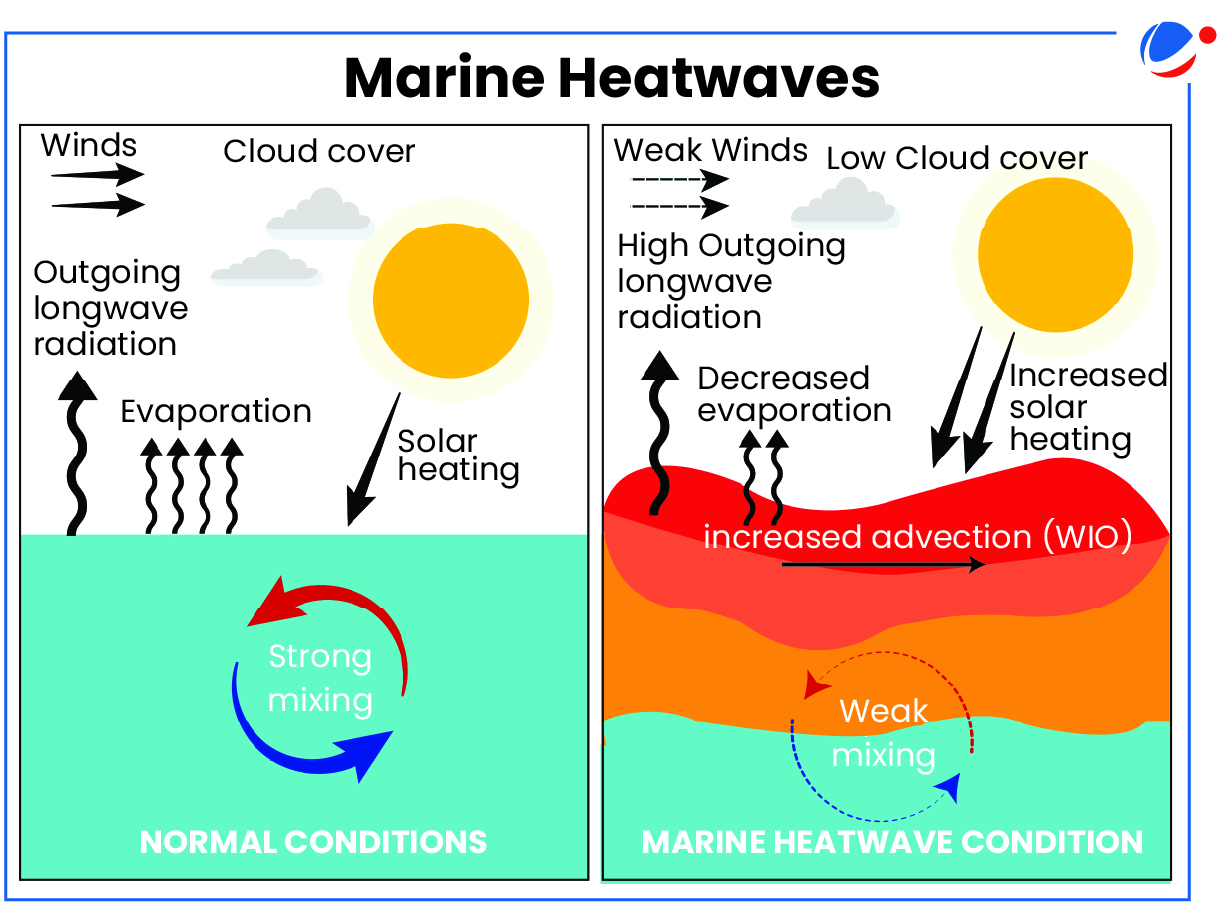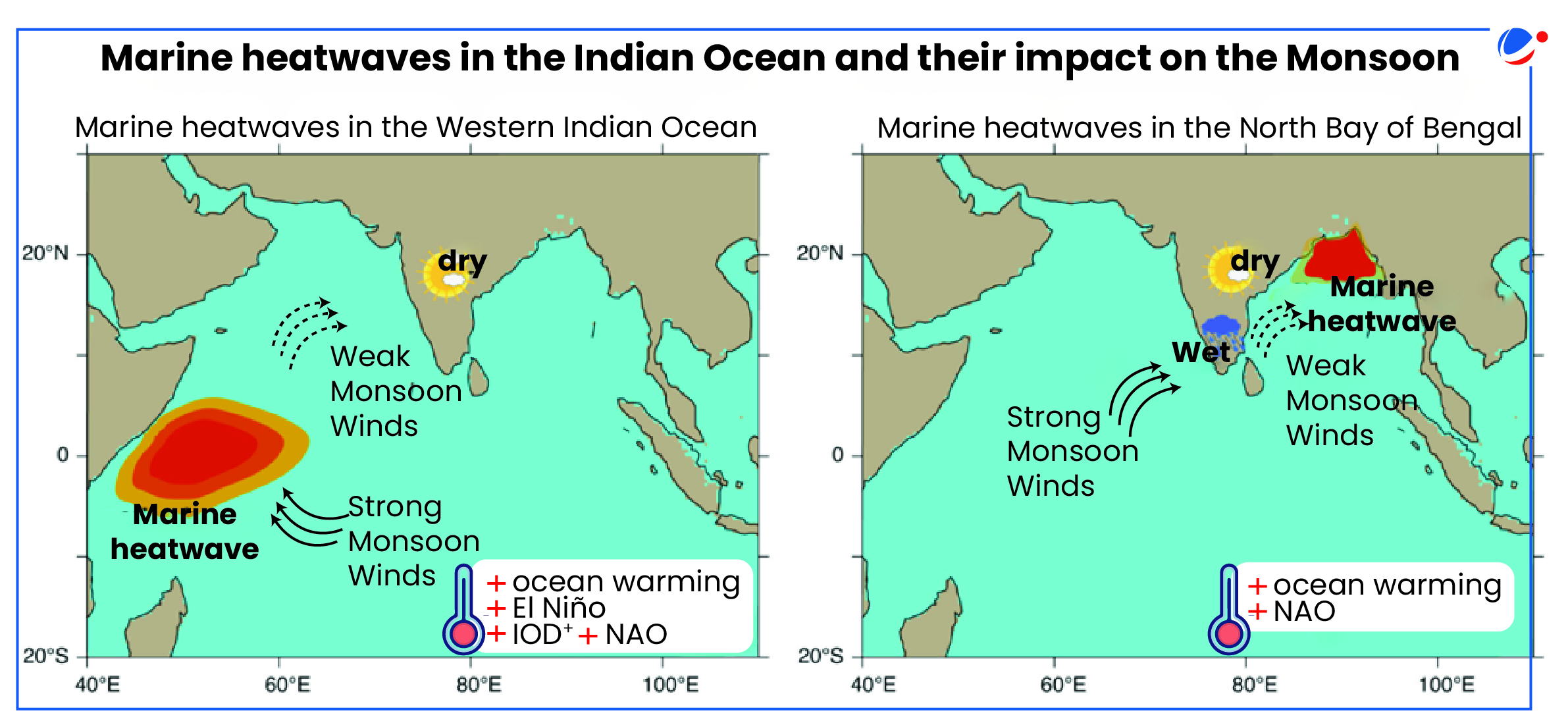Why in the News?
The world experienced a 240 per cent increase in the average number of marine heatwave (MHW) days in the summers of 2023-24 as per a study published in Nature Climate Change.
Key Finding of the study
- Trend: The past two years (2023–2024) have been the warmest on record across both land and ocean, and increases in MHWs due to anthropogenic heating are expected to continue.
- Global phenomena:Marine heatwaves observed all over globe, with 8.8% of the ocean experiencing the highest sea surface temperatures ever recorded; almost four times more than the historical annual average.
- Locations: Record-breaking events were particularly evident in the North Atlantic, southwest Pacific, eastern Pacific and western Indian Oceans.

What is a marine heatwave?
- Marine heatwaves (MHWs) are anomalously warm and sustained sea surface temperature extremes.
- It occurs when the surface temperature of a particular region of the sea rises to 3 or 4 degree Celsius above the average temperature for at least five days.
- No fix temperature: Unlike heatwaves that occur on land, there is no set temperature that defines a marine heatwave because ocean temperatures naturally vary in space and time.
- The ocean temperature is colder closer to the poles and warmer near the equator. At the surface they're warmer in summer and colder in winter.
- A marine heatwave is most commonly detected when the water is warmer than it was on 90 percent of previous measurements.
- Duration: MHWs can last for days, weeks, months or even years.
- Increase in frequency: The number of marine heatwave events has doubled since 1982.
Causes of marine heat wave
- Combination of atmospheric and oceanic processes: Such as blocking high pressure weather systems that develop over the Gulf of Alaska, in combination with remote tropical Pacific teleconnections, can cause sudden changes in oceanographic conditions leading to MHWs.
- The El Niño in the eastern tropical Pacific can result in long duration MHW events in this region.
- Surface heat flux: Heating from the atmosphere, this tends to occur when an atmospheric high-pressure system sits above a region of water for an extended period.
- The Coastal Peruvian 2017 MHW and the Tasman Sea 2017–18 MHW were associated with anomalously high heat fluxes from the atmosphere into the ocean.
- Advection: The movement of warmer waters into the region by ocean currents can also contribute to MHWs.
- For example; Western Australia 2011 MHW and the Tasman Sea 2015–2016 MHW caused primarily by anomalous horizontal advection of warm waters.
- Human induced Global warming: Oceans have absorbed 90 per cent of the additional heat caused by the release of greenhouse gases into the atmosphere in recent decades. This has increased the global mean sea surface temperature by close to 0.9 degree Celsius since 1850.
Impacts of the marine heat wave
- Biological impacts: These included a global coral bleaching event, loss of vital ecosystems such as kelp forests, sea grass, and coral reefs.
- 85 per cent of the corals in the Gulf of Mannar near the Tamil Nadu coast got bleached after the marine heatwave in May 2020 affecting the wider food web, raising concerns about potential impacts on fish populations.
- Influenced weather patterns: Due to 'supercharging' the heat and moisture exchanges between sea and air creating record number of storms and rainfall.

- In 2024, Hurricane Beryl (amplified by MHWs) became the earliest category 5 hurricane on record by time of year and devastated parts of the Caribbean and United States.
- Deoxygenating: Observations on the Baltic Sea reveal heatwaves can contribute to seawater oxygen deficiency, especially in the shallow areas.
- Impact on Monsoon rainfall: Marine heatwaves in the Bay of Bengal usually means a drier monsoon for central India and enhanced rain over India's southern peninsula.
- The northern Bay of Bengal had experienced an intense marine heatwave in June 2023 leading to India's usually arid northwest receiving extreme rainfall.
- Acidification Amplified by MHWs: Higher temperatures increase hydrogen ion concentration ([H⁺]), lowering pH and increasing acidity.
- Loss of livelihood and ecosystem services: Losses to aquaculture, due to increased temperatures negatively affects snorkeling and scuba diving tourism and fishing.
- MHW in the Pacific Ocean caused mass mortality of farmed salmon in Chile due to harmful algal blooms, with an estimated export loss of US $800 million.
- Sea-level rise: Heat causes the volume of water to increase, called the thermal expansion of water, and this is responsible for more than half of the sea-level rise in the Indian Ocean -larger than the changes arising from glacier and sea-ice melting.
Strategies to tackle marine heatwaves
- Proactive interventions to reduce impact: It included moving corals to deeper, cooler water to prevent bleaching and to assist mating as done in Florida.
- Reactive interventions: Can be carried out in response to already changing conditions, including fisheries closures and shifting fishing practices to target opportunistic species.
- Ex-situ conservation methods: In Tasmania, a quarter of the remaining population of the critically endangered red handfish were collected and maintained in an aquarium for the duration of MHWs to aid conservation.
- Geoengineering interventions: Ocean interventions such as the oxygenation of Macquarie Harbour, Australia and marine cloud brightening in the Great Barrier Reef and North Pacific can be helpful reducing heat exchange.
- Implementation of climate change initiatives effectively: As agreed to under the Paris Agreement governments must invest in renewable and nature-based solutions alongside ambitiously reducing fossil fuel-based emissions.
- Preparation of MHW forecasts: It Allow effective preparation, preparedness and mitigation measures. For example, in Australia, specific national briefings and regional response plans were developed to prepare decision-makers.



